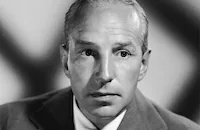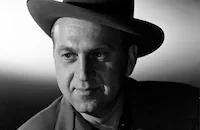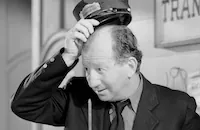Steel Against the Sky

Brief Synopsis
Cast & Crew
A. Edward Sutherland
Alexis Smith
Lloyd Nolan
Craig Stevens
Gene Lockhart
Edward Ellis
Film Details
Technical Specs

Synopsis
Two of the three Evans brothers, Rocky and Pete, work building bridges like their father did before them. The third brother, Chuck, is more interested in various foolish schemes for making money. Rocky, the foreman of his crew, is smitten by Helen Powers, the daughter of boss John Powers, and invites her to his home for dinner. While Pop Evans prepares an elaborate dinner to impress Helen, Chuck and Professor Sampson are at work in the family basement producing Sampson's latest invention. Shortly after Helen arrives, a hugh explosion issues from the basement and Rocky is overcome by the fumes. When Chuck accompanies Helen home, he learns that although Rocky is in love with her, she does not return his feelings. Helen challenges Chuck to find a real job, and the next day he gets himself assigned to Rocky's crew. Powers informs Rocky that in order to finish the bridge ahead of an expected storm, he must hire extra men. When Bugs Little, a man that Rocky fired for drunkenness, tries to apply, however, Rocky throws him off the property. Out for revenge, Bugs climbs up the bridge and attacks Rocky. The two men fight high above the ground until Chuck swings down and carries Bugs off the tower. Helen has watched the whole thing and offers to buy Chuck a cup of coffee. Rocky sees them leave together and descends to join them. After he sees them kiss, he quarrels with Chuck, who later moves away from home. When Rocky tells Powers that he wishes to be transferred to South America, Powers realizes that his daughter has come between the two brothers and advises her to straighten matters out. Helen then tells Chuck that she does not really love him, hoping this will cause him to make up with Rocky. When the big storm arrives, Rocky must go up on the bridge to fasten a loose derrick and picks Pete to go up with him. After Pete slips off the bridge into the water, where he is rescued, Rocky continues to climb alone. While others work to loosen the frozen elevator, Chuck climbs up after Rocky and rescues him. Once the two men are back on the ground, Helen admits that she really does love Chuck. His relationship with Chuck repaired, Rocky is best man at his brother's wedding.

Director
A. Edward Sutherland
Cast

Alexis Smith

Lloyd Nolan

Craig Stevens

Gene Lockhart

Edward Ellis

Walter Catlett

Howard Da Silva

Edward Brophy

Julie Bishop

Jackie Gleason

John Ridgely
Joe Devlin
Frank Faylen
Dick Wessell
Cy Ring
Billy Dawson
Reverend Neal Dodd
Creighton Hale
Herbert Gunn
George Lloyd
Don Turner
Reid Kilpatrick
Roland Drew

Jack Mower

Hank Mann
Frank Mayo
Bill Phillips
Pat Mcveigh
Charles Sullivan

Emmett Vogan

John Gallaudet
Billy Wayne
Weldon Heyburn
Pat O'malley
Ed Hearn
Crew
Robert Foulk
Bryan Foy
Doug Gould
Edmund Grainger
Maurice Hanline
Jesse Lasky Jr.
M. L. Lipsett
Charles Novi
Phil Quinn
Francis J. Scheid
Howard Shoup
Paul Gerard Smith
Willard Van Enger
James Van Trees
Perc Westmore

Film Details
Technical Specs

Articles
Steel Against the Sky (1941) - Steel Against the Sky
Steel Against the Sky, released by Warners in 1941, is a prime specimen of the breed. Dedicated to "the bridge builders who courageously wrestle hundreds of feet above the earth with girders and cables...night and day, in broiling sun and driving storm," it ignores ivory-tower architects and front-office executives, focusing instead on the working guys who make great structures out of their own sweat, tenacity, and toil. It's a generic studio picture, complete with melodramatic action, unsubtle gags, hardboiled dialogue, and romantic rivalry. But it has the virtues of energy, sincerity, and economy, and with its tight 68-minute running time it's well worth a look.
Once the above-quoted dedication has crawled across the screen, the picture opens with a burst of music and an eye-dazzling montage of construction workers practicing their trade while perched at vertiginous heights on slender shafts of steel. In this heady atmosphere we meet Pete Evans (Edward Brophy), whose family is at the center of the plot. Although he's basically a comic character, he kicks off the dialogue with a complaint: "The sun shines, you get sunburned. If it rains, you get rheumatism. No matter what kind of a day it is, there's always weather!"
There are worse things, too. No sooner has Pete finished his soliloquy than a worker named Bugs (Howard da Silva) commits a cardinal sin by dropping a wrench that plummets dangerously to earth, almost conking Pete's brother, foreman Rocky Evans (Lloyd Nolan), on its way down. Bugs has been drinking, it turns out, and not for the first time. That's an intolerable offense in these hazardous circumstances, and sure enough, Rocky fires the unrepentant laborer on the spot. This brief conflict gives the story a high-octane beginning and paves the way for a major plot twist later on.
We move next to the Evans house, where we get a more complete picture of the clan. The gentle patriarch is Pop (Edward Ellis), a widower with a crusty manner, a heart of gold, and three grown sons sharing his home. The oldest is Rocky, the foreman; the middle one is Pete, the grumpy worker; and the youngest is Chuck (Craig Stevens), who'd rather invest in crazy schemes than work with the others at the bridge-building site. And of course there's a lady in the picture: Helen (Alexis Smith), the beautiful daughter of John Powers (Gene Lockhart), who supervises the construction company's operations.
Rocky invites Helen for dinner with the family, hoping to cultivate a romance. Helen hits it off with Chuck, however, leading Chuck to stop lollygagging about and take a manly job at the construction site, where extra workers are needed because an approaching storm has speeded up the schedule. Bugs now returns, hoping to wheedle his way back onto the crew. Rocky throws him out, whereupon he sneaks into the site and sparks a high-altitude fistfight, imperiling Rocky until Chuck heroically saves the day. Helen now reveals her love for Chuck, angering Rocky so much that he asks for a transfer to another project in a faraway country.
The climax takes place high atop a tower during the raging storm, after which the brothers are reconciled and family harmony reigns. An old workplace injury suffered by Pop also plays a part in the story, and there's a very silly subplot about a Professor Sampson (Walter Catlett), a screwy scientist whose fabulous invention - a substance called Samsonite, no relation to the luggage brand - proves good for nothing except setting off explosions in Pop's basement.
The movie was directed by A. Edward Sutherland, a dependable professional whose previous pictures range from comedies - including the W.C. Fields vehicle Tillie's Punctured Romance (1928) and The Flying Deuces (1939) with Laurel and Hardy - to dramas like Diamond Jim (1935), fantasies like The Invisible Woman (1940), and musicals like The Boys from Syracuse (1940). In making Steel Against the Sky he faced the challenge of blending stock documentary footage (some of it possibly from the 1940 collapse of Washington's Tacoma Narrows Bridge) with material obviously shot on a Warner Bros. soundstage. He manages the task reasonably well, giving the bridge-tower scenes a veneer of realism that almost obfuscates the obvious artifice of certain studio effects, such as icicles concocted (according to a trade magazine) from paraffin and sugar.
Critics have noted the similarity of Steel Against the Sky to The Irish in Us, a family-centered comedy with James Cagney, Pat O'Brien, and Olivia de Havilland released by Warners in 1935. But originality isn't the point of this competently crafted, cheerfully predictable picture. What's at stake is the drama, romance, and comedy to be found in the kind of working-class family that Warner Bros. considered its core audience. On that level it's a modest, likable entertainment.
Director: A. Edward Sutherland
Screenplay: Paul Gerard Smith; from a story by Maurice Hanline and Jesse Lasky, Jr.
Cinematography: James Van Trees
Film Editing: Doug Gould
Art Direction: Charles Novi
Cast: Alexis Smith (Helen Powers), Lloyd Nolan (Rocky Evans), Craig Stevens (Chuck Evans), Gene Lockhart (John Powers), Edward Ellis (Pop Evans), Walter Catlett (Professor Sampson), Howard da Silva (Bugs), Edward Brophy (Pete Evans), Julie Bishop (Myrt).
BW-68m.
by David Sterritt

Steel Against the Sky (1941) - Steel Against the Sky
Quotes
Trivia
Notes
The film's working titles were The High Tower and Bridges Built at Night. The film begins with the following written statement: "The growth of man's engineering achievements is written in gigantic structures of stone and steel which have surmounted the formidable barriers of gulf and raging torrents. To the bridge builders who courageously wrestle hundreds of feet above the earth with girders and cables of steel, night and day, in broiling sun and driving storm, we dedicate this picture...." Although Gene Lockhart's character is called "John Powers" in the credits, a newspaper headline in the film announcing the wedding of "Chuck" and "Helen" calls her father "Frederick Charles Powers."
Hollywood Reporter news items dated 15 May and July 15, 1941 note that shots of the collapse of the Tacoma Narrows Bridge in Tacoma, WA, were to be used in the film, and that Lew Seiler was to direct the picture. According to a brief article in American Cinematographer, icicles hanging from the film bridge were made from a combination of parafin and melted sugar. The film's story closely resembles that of the 1935 Warner Bros. film The Irish in Us (see AFI Catalog of Feature Films, 1931-40; F3.2158).















